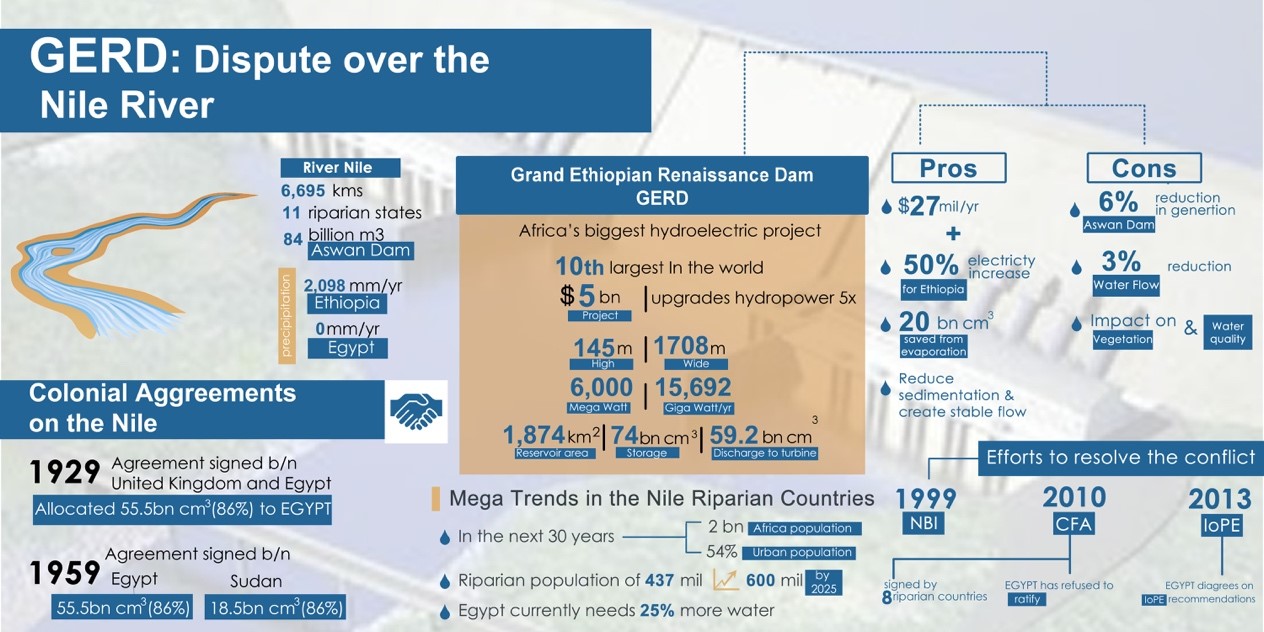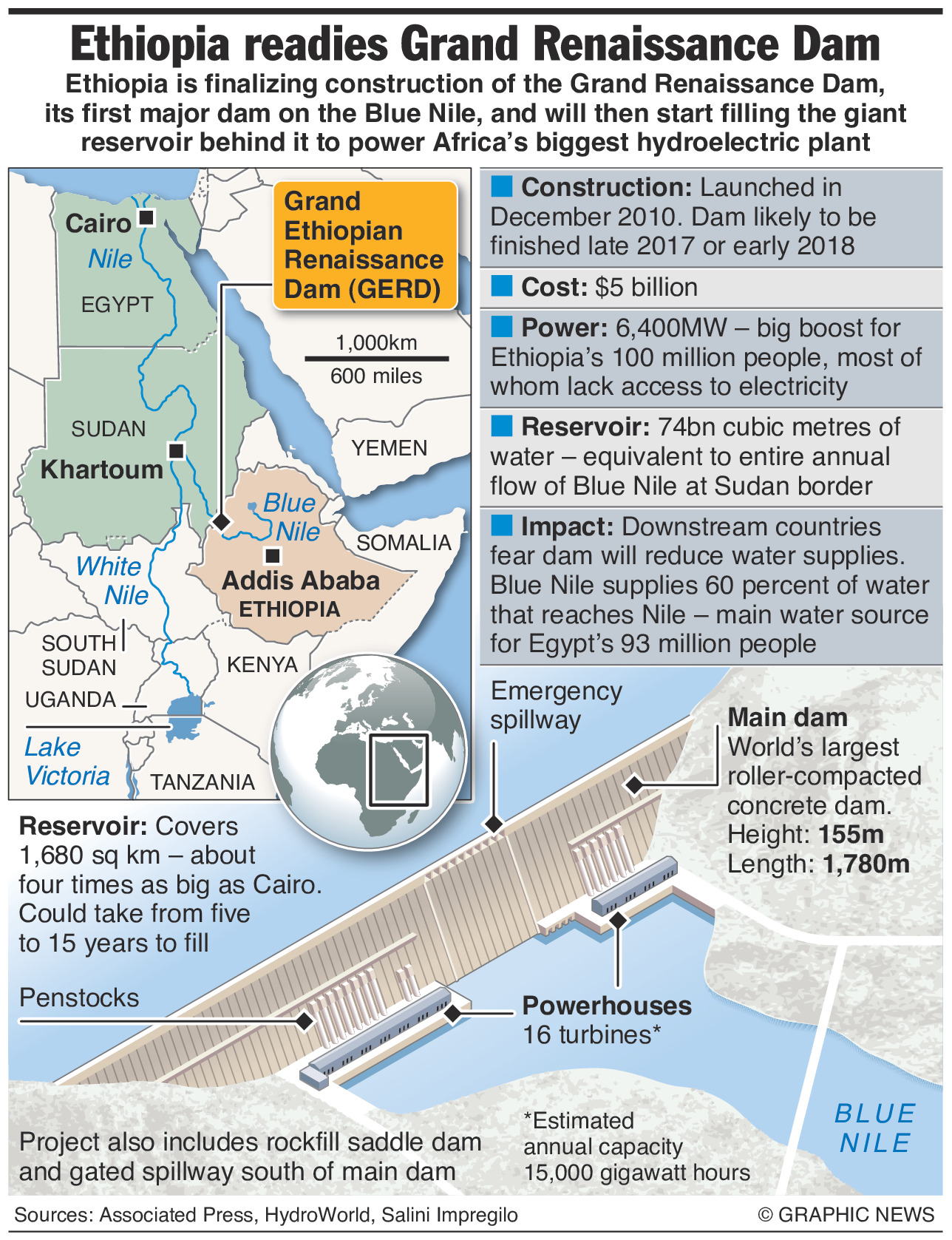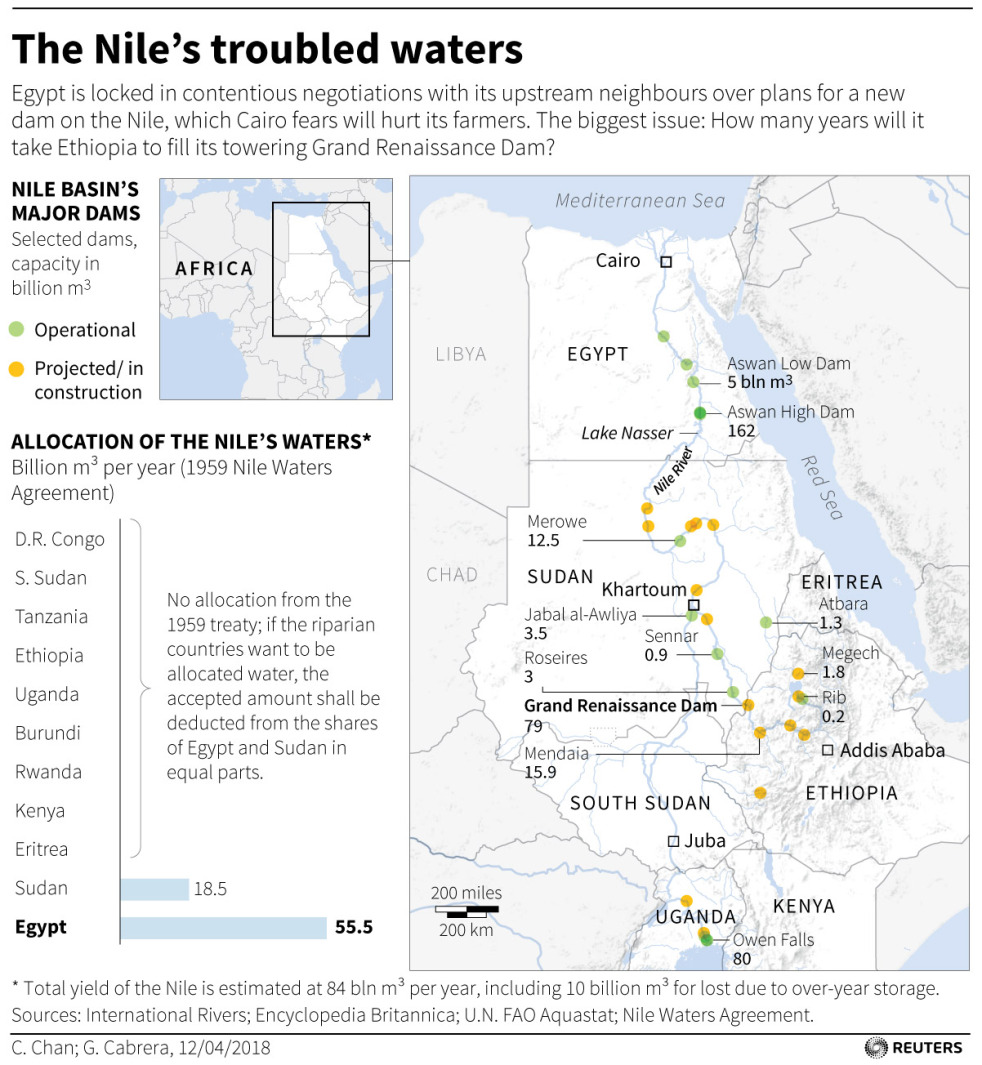Original Analysis: https://studies.aljazeera.net/en/reports/emergence-another-african-conflict-egypt-ethiopia-and-geopolitics-renaissance-dam
Mehari Taddele Maru
Very few consider that despite the possibility of conflict or cooperation, such changes in the exploitation of the Nile River resources are due to changing relations and the need to address long-standing unfair and hegemonic approaches to trans-boundary resource sharing.
The standoff between the Nile riparian countries Egypt, Sudan and Ethiopia over the mega dam project by the latter has taken a new twist. The current US administration which has led over four months of negotiation over the Grand Ethiopian Renaissance Dam (GERD) has warned Ethiopia that “final testing and filling [of the dam] should not take place without an agreement” with Egypt and Sudan. (1)
On February 27-28, President Donald Trump’s administration called for a fifth ministerial meeting of the three countries that commenced in November 2019. Requesting for more time for domestic consultations, Ethiopia failed to attend the meeting while Egypt and Sudan had bilateral meeting with the US Treasury Secretary Steven T. Mnuchin. The US administration praised Egypt’s willingness to sign the agreement it prepared with the World Bank and recognised that Ethiopia was still consulting on the matter and need to sign as soon as possible.
In a statement by US Treasury Secretary, the Trump administration has imposed three demands on Ethiopia: first, to ensure that “final testing and filling should not take place without an agreement”; second, to sign the agreement after finalizing the consultations; and finally, “the need to implement all necessary dam safety measures in accordance with international standards before filling begins.”
In response, Ethiopia has announced “as the owner of the GERD, [it] will commence filling the GERD in parallel with the construction of the dam, in accordance with the principles of equitable and reasonable utilization and the causing of no significant harm.” (2) This has attracted the attention of Egypt, which warned Ethiopia that it will “defend with all means available the interests of Egyptian people, their fate and future.” (3) The Egyptian media has depicted the dam as a proxy war by Qatar, Turkey and Iran in their regional rivalry since the rift in GCC. Israel has also been drawn in, with accusations that it is supporting Ethiopia by providing technology and military support in securing the dam.
Trump’s administration seems ready to use its diplomatic power including its departments and the World Bank to pressure Ethiopia to agree to some of Egypt’s demands. President Trump’s mediation initiative on GERD is unusual. Jacob Wirtschafter, a Washington Times journalist, has described the administration as “playing the unlikely role of peacemaker.” (4)
This paper examines the row between Ethiopia, Egypt and Sudan on the GERD built on the Nile River. It examines the respective claims and measures taken to resolve the dispute and the, the geopolitical and strategic significance of the row. It also highlights the role of international actors and external factors including resolution mechanisms that have been applied.
The Sticking Points
Egypt, Ethiopia and Sudan have held tripartite negotiations over the Nile for the past seven years. The contention between the three countries has been over the use of the river and the GERD. Ethiopia asserts that the GERD will not harm Egypt. Egypt disagrees. Ethiopia avers that it is only claiming its right to utilize one of its resources for national development under international law of equitable use of transboundary water bodies. Egypt claims its rights under international agreements.
The sticking points include water security associated with the volume stored and stages of impounding the dam; dam safety; and water quality. The recent dispute over the definition of ‘drought’ and ‘severe drought’ is related to the filling and management of the dam and its implications for water security. Some of the claims are based on research evidence but others are nationalist ideology-based positions. Research has a place in the negotiations but little influence. However, strategic national interest takes more significance even for the US. Ultimately, these are enmeshed with policy sovereignty and international law.
Cognisant of the need to directly speak to his Ethiopian counterpart, President Abdelfatah El Sisi, in a live broadcast, asked Prime Minister Abiy Ahmed to swear “before God and the people of Egypt” that he will not hurt their share of the Nile waters. Abiy responded, “We will take care of the Nile and we will preserve your share and we will work to increase this quota.” Yet despite these public assurances, negotiations have failed to produce an agreement. They have turned into zero-sum game with each country trading accusations against the other. Egypt fears the GERD portends water scarcity. But for Ethiopia and other riparian countries, the GERD is a symbol of assertiveness in reclaiming a share of the Nile water resource.

The Nile River Basin
The Nile is longest river in the world at 6,695km. It is shared by 11 riparian states, namely Burundi, the Democratic Republic of Congo (DRC), Kenya, Egypt, Ethiopia, Rwanda, South Sudan, Sudan, Tanzania, Uganda, and Eritrea. The mean annual flow of the Aswan dam is 84 billion cubic meters of water. About 86 to 95 percent of the flow of water to the Aswan dam comes from Ethiopia. The largest freshwater lake, Victoria and the Sudd wetlands are located in this Basin. While the annual maximum precipitation is 2,098 mm per year in Ethiopia, there is almost no rainfall in Egypt that feeds into the Nile. The Ethiopian highlands are also a source of fertile soil sedimentation for irrigation and brick production in Egypt and Sudan. (5)
Grand Ethiopian Renaissance Dam (GERD)
The Grand Ethiopian Renaissance Dam (GERD) is Africa’s biggest hydroelectric project and the 10th largest in the world. It is a $5 billion project that was expected to increase the country’s hydroelectric power capacity fivefold by 2018. Commenced in April 2011, the construction of the dam was a source of controversy between Egypt and the other riparian countries. With a reservoir area of 1,874 km2 the dam has a total storage volume of 74 billion cubic meters of water. Of these, 59.2 billion cubic metres will discharge water to the turbines. The dam wall is 145m high and 1,708m wide. According to earlier plan, its turbines can generate 6,000 MW of electricity and 15,692 Giga Watt hours of energy per year. (6) This is clean energy that will help mitigate the human impact on climate change globally and, according to an Independent Panel of Experts (IPoE), will benefit Egypt, Sudan and Ethiopia. (7)
Some observers argue that the GERD could lead to inter-state war between Ethiopia and Egypt. (8) Others downplay the potential for violent conflict over the GERD, contending that the dam could facilitate enhanced cooperation. (9) Very few consider that despite the possibility of conflict or cooperation, such changes in the exploitation of the Nile River resources are due to changing relations and the need to address long-standing unfair and hegemonic approaches to trans-boundary resource sharing. (10)

Historical Perspective
Rivalry over the Nile River has been one of the most stubborn impediments to peace and stability in the Horn of Africa, particularly for Ethiopia. For a long-time, Egypt has claimed its historical right to an annual quota of 55.5 billion cubic meters of Nile waters. This claim has threatened Ethiopian water resources totalling to 86 percent of Nile waters.
In 1929, an agreement was signed between Egypt and the United Kingdom on usage of the Nile waters. Subsequently, in 1959, an agreement was signed between Egypt and Sudan that excluded all the other riparian countries. Based on the 1959 treaty, Egypt claims that it has an ‘historical’ and ‘acquired’ right to 55.5 billion cubic meters of water. Sudan was allocated 18.5 billion cubic meters. These two agreements excluded Ethiopia, the only independent country among the relevant riparian states. It is necessary to mention here that Ethiopia, which is the source of 85 percent of Nile waters courtesy of the Blue Nile and the Atbara, was allocated no water for its use under these treaties. If this fixed allocation of the total volume of waters is apportioned, Egypt would have monopoly over the Nile as, from time to time, the volume of water could fall to less than 80 billion cubic meters.
Since 1970, Ethiopia has wanted to develop the Nile waters. It first approached an American company to conduct an impact study of dam construction on the Nile. This so infuriated Egypt that the former president Anwar Sadat, threatened to attack Ethiopia. (11) As Sudanese scholar on water resources Salman Ahmed pointed out in a 2013 article, in the past five decades British colonial administrations and previous Egyptian governments followed a successful strategy of threatening and dissuading external financial assistance to Ethiopia and the other riparian states. They thereby weakened Ethiopia’s internal capacity to construct the dam. (12) As a result, Ethiopia was only able to finance the dam by mobilizing resources through domestic means.
Before the current progress could be achieved, Egypt used three strategies to impede Ethiopia’s plans to implement water development projects at the headwaters of the Nile: 1) threatening military action; 2) thwarting any external funding requests made by Ethiopia to develop its water resources using its diplomatic advantage and 3) destabilizing Ethiopia by encouraging neighbouring countries to do so and by supporting domestic rebel groups. (13)

The Nile and Geopolitical Changes
More than any other factor, crucial geopolitical and geo-economic developments have caused, accelerated or triggered the current tensions in the Nile Basin. The first relates to relative stability and development in upstream countries. Civil wars have characterized the internal security dynamics of the upstream countries including Ethiopia. As a result, cooperation among the riparian states was almost impossible. Compared to previous decades, particularly during the Cold War, the region has experienced greater stability. Second, with enhanced stability, the upstream countries have improved their economic performance.
Third, a consequence partially attributable to relative stability and development, is the shift in the relative geopolitical and geo-economic importance of the region to the major powers in the West and East. In the past two decades, Ethiopia’s influence on the regional and continental agenda (by extension its global role) has increased drastically so that it has become a major ally of the great powers. Fourth, a cumulative effect of these changes brought a slight shift of vision by the international community, particularly in regard to global governance institutions and the emergence of China and other sources of developmental investment in various urgent projects such as infrastructure in the upstream countries. Assertiveness within the Nile basin countries has surged significantly. This has created tensions over the Nile that require a more robust legal and institutional framework to govern the various interests of the riparian countries.
Furthermore, the international community has sensed the need for a more collaborative mechanism to pursue peaceful routes towards partnership in the development of the Nile basin. (14)Nonetheless, since 2018, shift in US priorities in East Africa has also introduced a number of other major changes in the region. First, it has further diminished the importance the US gives to supporting the armies of countries in the Horn of Africa, particularly that of Ethiopia. With regard to regional security and foreign policy, the armies’ role may diminish, except for UN peacekeeping purposes.
Mega Trends
The population of eastern African countries, which includes almost all riparian countries except the DRC, will grow to constitute almost half of Africa’s. (15) With the population bulge, water, food, energy and other essential commodities’ consumption will surge. Egypt contributes no water to other riparian states and currently needs 25 percent more than it gets. (16) In 2025, it is predicted that the water per capita in the country will be reduced to 337m3. (17) ore than any other factor, crucial geopolitical and geo-economic developments have caused, accelerated or triggered the current tensions in the Nile Basin. Relative stability and development in upstream countries, improved their economic performance, geopolitical and geo-economic importance of the region to the major powers in the West and East have brought a slight shift of vision by the international community. Assertiveness within the Nile basin countries has surged significantly. (18)
With regard to the GERD, the IPoE report outlines the main concerns by Egypt as: the reduction in the volume of water (water security), the safety of the dam, and quality of the water.
During the initial years, the filling of the dam may result in low levels of water mainly for hydropower generation in the Aswan High Dam of Lake Nasser. Indeed, the IPoE calculated that there would be a maximum of 6 percent reduction in hydropower generation, while the water flow reduction would be less than 3 percent. (19) The IPoE has also raised some questions related to the economic cost-benefits of the dam, particularly the costs of main loading and transmitting power generated by it. (20) However, this concern could be easily addressed by consulting about the optimal time for filling the dam during the rainy season. Moreover, the IPoE recommended some further measures to ensure the safety of the dam.
The concerns raised by the IPoE about the safety of the dam will be important for both Sudan and Egypt. Of all the riparian countries, the safety of the dam would most benefit Ethiopia by ensuring the prudent usage of its $4.8 billion investment. Moreover, in the words of the IPoE itself, the contractor building the dam is a world-class company that has “designed and constructed over 200 large dams around the globe”. (21) After several discussions, field visits, surveys, and document analyses, the IPoE confirmed that the ongoing construction of the dam complies with international standards. They further noted that the security of the dam engineering was proved to conform to the standards of the International Commission on Large Dams. It assured that it would only have a minimal impact on the level of water. (22)
The IPoE raised some minor concerns about the impact of the vegetation around the dam on the quality of the water. The methane gas produced from decaying dead vegetation and soil in the lake due to flooding, could threaten the water quality and biosafety of the basin. This, according to the IPoE, will have implications for aquatic life including fishing and agriculture. Accordingly, the IPOE recommended that Ethiopia speed up the clearing of vegetation to reduce sedimentation and methane gas in the river. The IPoE agreed that the dam will not cause significant harm to the water security of Egypt and Sudan. It also put to rest Egypt’s three fears of adverse effects.
While there were many recommendations for further studies on climate change and environmental impact, sedimentation, the need for different impounding options, and the equilibrium of water levels in downstream countries, the IPoE attested that the dam could benefit all riparian and neighbouring countries, particularly Ethiopia, Sudan and Egypt. According to some estimates, the dam will generate $27 million per day for Ethiopia, and increase the total electricity access in Ethiopia to 50 per cent. (23) Despite this significant achievement, tens of millions of Ethiopians are still likely to remain without electricity for decades, particularly in rural areas.
Conclusions and Lessons Learned
The GERD signify a paradigmatic shift in relationships among Nile riparian countries, and it offers a mechanism for collaborative partnerships in accordance with international law and with the close support of the global community.
The dispute about the Nile, and GERD is being manipulated by nationalistic political inputs to advance domestic power struggles. The interdependence of riparian states supported by multilateral mechanisms should be sufficient to prevent conflicts among them.
The integration of early warning systems pertaining to climate, weather, and environmental changes together with conflict early warning procedures should be paramount for building predictive and responsive capabilities in such river basins.
The Nile and GERD can be an integrative opportunity for creating interdependence among the riparian countries. While the envisaged GERD and any other hydroelectric project on the river could be considered as integrative factors and could effectively enhance opportunities for geopolitical interdependence,
The chairpersons of the African Union and the African Union Commission may consider calling a preventive diplomacy and mediation of all the riparian countries to seek means of reaching “a win-win situation” of Pan-African solution to this African problem.
To avoid and reduce the triggers of conflicts over trans-boundary water resources and enhance cooperation, the AU needs to elaborate a continental declaration on the adoption of the UN Convention on Water Resources.